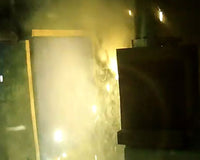Also sometimes referred to as electrical equipment hazard labels or arc flash stickers, arc flash warning labels provide workers with important information relating to voltages or about the potential of an electrical explosion occurring.
These labels give an indication as to the level of PPE and arc flash clothing that needs to be worn in order to stay safe whilst working on or near a particular piece of equipment.

Where are arc flash labels required?
In accordance with NFPA 70E regulations, arc flash warning labels are required on any piece of electrical equipment that may need to be examined, adjusted, serviced, and / or maintained whilst still energized. This typically includes equipment, such as switchboards, transformers, enclosed circuit breakers, industrial control panels, external variable frequency drives etc.
Electrical equipment that does not require an arc flash warning label includes things like internal meters, lighting control panels, motors, safety switches, meter control sockets, surge protective devices (SPDs), transient voltage surge suppressors (TVSSs) etc. These lists are by no means exhaustive.
At what voltage are arc flash labels required?
The NFPA 70E regulations state that any electrical equipment operating at 50 volts or more, and “likely to require examination, adjustment, servicing, or maintenance while energized” requires an arc flash warning label.
Are arc flash labels required on disconnects?
According to NFPA 70E, labels are required on any piece of electrical equipment that may need examination, adjustment, service or maintenance while energized. The labels communicate the electrical hazards a worker may be exposed to, including the potential for an arc flash incident.
In order to stay compliant, arc flash labels must be placed on disconnect switches where multi-conductor cables or bundled wires/cables exist.
What should be on an arc flash warning label?
At the very least an arc flash warning label should state the hazards that are present, e.g. arc flash hazard, shock hazard. However, on its own this information is not all that useful for a worker. They need to know much more information in order to know what tools to use for the job and the level of PPE and arc flash clothing to wear in order to be safe.
An arc flash warning label should contain a warning message, the incident energy (in cal/cm2), working distance, arc flash boundary, shock hazard level (volts), limited approach boundary, restricted approach boundary, glove class, and equipment and label information.
With all of this information on an arc flash warning label, your workers will know exactly what the hazards are and how to keep safe.
Where do you put arc flash labels?
Arc flash labels must be placed on any piece of electrical equipment where workers may need to perform jobs on it whilst it is still energised. This includes equipment like switchboards, panelboards, and meter socket enclosures.
What boundaries are typically shown on the arc flash labels?
Arc flash boundary - this is the distance from a possible arc source to where the incident energy falls to 1.2 calories per square centimetre. If a worker is standing at this distance from the arc source, they may experience second degree burns. Workers who aren’t protected with the appropriate PPE must stay outside of the arc flash boundary in order to remain safe. Workers inside of the arc flash boundary require all parts of their body protected.
Limited approach boundary - this is designed in order to keep workers who are unqualified safe from shock hazards. Unqualified worker can only cross this boundary if they are escorted by a qualified worker or if the electrical hazard has been eliminated by placing the equipment in a condition that is electrically safe.
Restricted approach boundary - only qualified workers are allowed to cross into the restricted approach boundary. Inside the boundary, accidental movement can put conductive tools or a part of the body in contact with live parts. To cross the restricted approach boundary, a qualified worker should be insulated by wearing appropriately rated rubber gloves. If any tools are used, they should be insulated. Under no circumstance should workers who are unqualified enter the boundary.
How often do arc flash labels need to be updated?
The NFPA 70E regulations recommend that an arc flash risk assessment is updated whenever a major renovation or modification takes place. It should be reviewed periodically, at intervals that do not exceed 5 years. This is to account for changes in the electrical distribution system that could impact the results of the arc flash risk assessment.
How to read an arc flash warning label:

1. Incident energy
This part of the warning label refers to the amount of Thermal Energy you will be exposed to in the event of Arc Flash from the source. This information is crucial as it will help you to select the appropriate Arc Flash PPE for the job as it will need to withstand the incident energy listed.
2. Arc Flash Boundary
This part of the label tells you how far away you will need to place a barricade to stop unqualified workers or those wearing everyday clothing rather than appropriate protective equipment. The boundary actually refers to the distance where someone without PPE would receive second-degree burns, so be sure to place your barricades further away than the figure listed. According to the Stoll skin burn injury model, the onset of a second degree burn on unprotected skin is likely to occur at an exposure of 1.2 cal/cm2 (5 J/cm2) for one second.
3. Available fault current
This part of the label shows the amount of current supplied by the electrical equipment’s upstream device. Typically this information is used for service entrance equipment and generic warning labels.
4. Recommended PPE
This is a list of recommended shock and arc flash personal protective equipment (PPE) that should be worn when working on equipment that is not placed in an electrically safe condition. This section may include company specific PPE requirements.
5. Working Distance
This often gets confused with the Limited Approach Boundary, but this part of the warning label actually refers to the distance required between the torso of the worker and the potential source of Arc Flash.
6. Nominal Voltage
This is a value assigned for conveniently designating a voltage class. Lots of electrical workers have been injured due to using test equipment rated for 1,000 volts on circuits energised at 4,160 volts or above. This information makes workers aware of the nominal voltage and so they can use it to select the proper test instrument, PPE and specific work practices to ensure their safety.
7. Glove Class
Some (but not all) Arc Flash Warning labels will tell you the glove class you need to work with the equipment once the cover has been removed, so make sure that any gloves you have are suitable to avoid burns.
8. Limited Approach Boundary
This part of the label refers to the boundary distance from an exposed energised electrical conductor or circuit part where a shock hazard can be felt. This is the distance where untrained, unqualified or members of the public should be kept away from the source.
9. Restricted Approach Boundary
Once inside the restricted approach boundary, you need to ensure that you are wearing the appropriate PPE as at this distance from an exposed conductor, the risk of arc over is increased.Ensure that you have the correct PPE including insulated rubber gloves within this boundary.
Is arc flash labelling required by OSHA?
OSHA has no specific requirement to mark equipment with flash hazard warnings. However, employers are required to mark electrical equipment with descriptive markings, including the equipment's voltage, current, wattage, or other ratings as necessary. OSHA believes that this information, along with the training requirements for qualified persons, will provide workers with the necessary information in order to protect themselves from an arc flash incident.
In addition to this, OSHA requires employers to use alerting techniques, such as safety signs and tags, barricades, and attendants in order to warn and protect workers from hazards which could cause injury due to electric shock, burns or failure of electric equipment parts. Although there isn’t a specific requirement for electric equipment to be marked to warn qualified persons of arc flash hazards, there is a requirement to use safety signs, safety symbols, or accident prevention tags to warn employees about electrical hazards which may endanger them.




